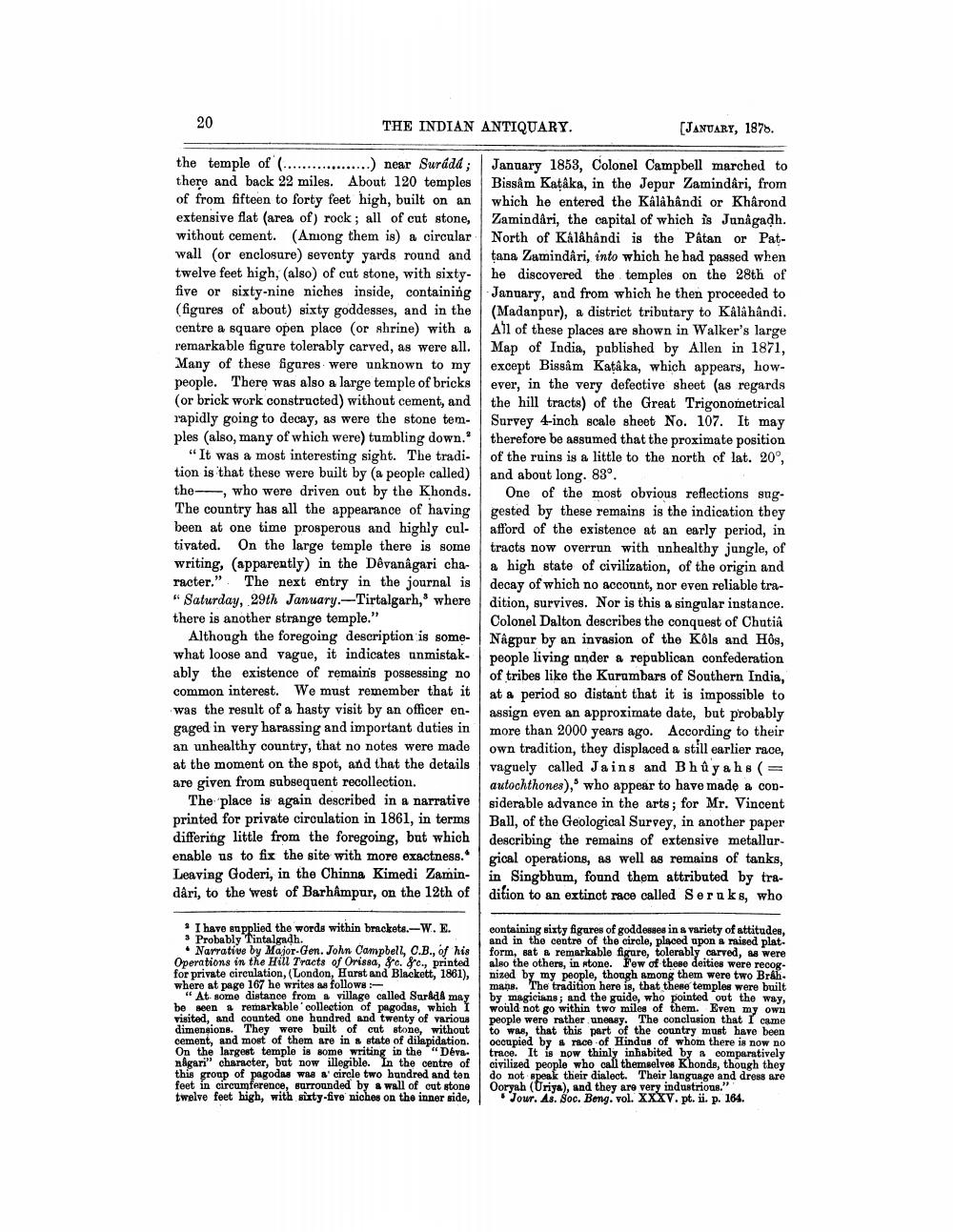________________
20
THE INDIAN ANTIQUARY.
the temple of (...) near Surádá; there and back 22 miles. About 120 temples of from fifteen to forty feet high, built on an extensive flat (area of) rock; all of cut stone, without cement. (Among them is) a circular wall (or enclosure) seventy yards round and twelve feet high, (also) of cut stone, with sixtyfive or sixty-nine niches inside, containing (figures of about) sixty goddesses, and in the centre a square open place (or shrine) with a remarkable figure tolerably carved, as were all. Many of these figures were unknown to my people. There was also a large temple of bricks (or brick work constructed) without cement, and rapidly going to decay, as were the stone temples (also, many of which were) tumbling down.
"It was a most interesting sight. The tradition is that these were built by (a people called) the, who were driven out by the Khonds. The country has all the appearance of having been at one time prosperous and highly cultivated. On the large temple there is some writing, (apparently) in the Dêvanâgari character." The next entry in the journal is "Saturday, 29th January.-Tirtalgarh, where there is another strange temple."
Although the foregoing description is somewhat loose and vague, it indicates unmistakably the existence of remains possessing no common interest. We must remember that it was the result of a hasty visit by an officer engaged in very harassing and important duties in an unhealthy country, that no notes were made at the moment on the spot, and that the details are given from subsequent recollection.
The place is again described in a narrative printed for private circulation in 1861, in terms differing little from the foregoing, but which enable us to fix the site with more exactness. Leaving Goderi, in the Chinna Kimedi Zamindâri, to the west of Barhampur, on the 12th of
I have supplied the words within brackets.-W.. E. 3 Probably Tintalgadh.
Narrative by Major-Gen. John Campbell, C.B., of his Operations in the Hill Tracts of Orissa, &c. &c., printed for private circulation, (London, Hurst and Blackett, 1861), where at page 167 he writes as follows:
"At some distance from a village called Surâdâ may be seen a remarkable collection of pagodas, which I visited, and counted one hundred and twenty of various dimensions. They were built of cut stone, without cement, and most of them are in a state of dilapidation. On the largest temple is some writing in the "Déva nagari" character, but now illegible. In the centre of this group of pagodas was a circle two hundred and ten feet in circumference, surrounded by a wall of cut stone twelve feet high, with sixty-five niches on the inner side,
[JANUARY, 1878.
January 1853, Colonel Campbell marched to Bissâm Kataka, in the Jepur Zamindari, from which he entered the Kâlâhândi or Khârond Zamindari, the capital of which is Junagadh. North of Kâlâhândi is the Pâtan or Pattana Zamindari, into which he had passed when he discovered the temples on the 28th of January, and from which he then proceeded to (Madanpur), a district tributary to Kâlâhândi. All of these places are shown in Walker's large Map of India, published by Allen in 1871, except Bissâm Kataka, which appears, however, in the very defective sheet (as regards the hill tracts) of the Great Trigonometrical Survey 4-inch scale sheet No. 107. It may therefore be assumed that the proximate position of the ruins is a little to the north of lat. 20°, and about long. 83°.
One of the most obvious reflections sug gested by these remains is the indication they afford of the existence at an early period, in tracts now overrun with unhealthy jungle, of a high state of civilization, of the origin and decay of which no account, nor even reliable tradition, survives. Nor is this a singular instance. Colonel Dalton describes the conquest of Chutia Nagpur by an invasion of the Kôls and Hôs, people living under a republican confederation of tribes like the Kurambars of Southern India, at a period so distant that it is impossible to assign even an approximate date, but probably more than 2000 years ago. According to their own tradition, they displaced a still earlier race, vaguely called Jains and Bhuyahs (= autochthones), who appear to have made a considerable advance in the arts; for Mr. Vincent Ball, of the Geological Survey, in another paper describing the remains of extensive metallurgical operations, as well as remains of tanks, in Singbhum, found them attributed by tradifion to an extinct race called Seruks, who
containing sixty figures of goddesses in a variety of attitudes, and in the centre of the circle, placed upon a raised platform, sat a remarkable figure, tolerably carved, as were also the others, in stone. Few of these deities were recog nized by my people, though among them were two Brahmans. The tradition here is, that these temples were built by magicians; and the guide, who pointed out the way, would not go within two miles of them. Even my own people were rather uneasy. The conclusion that I came to was, that this part of the country must have been occupied by a race of Hindus of whom there is now no trace. It is now thinly inhabited by a comparatively civilized people who call themselves Khonds, though they do not speak their dialect. Their language and dress are Ooryah (Uriya), and they are very industrious."
Jour. As. Soc. Beng. vol. XXXV. pt. ii. p. 164.




